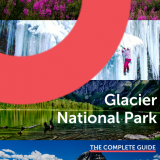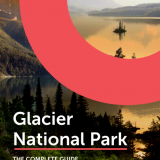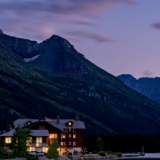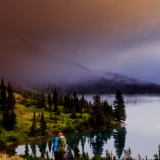At Glacier National Park, the very ground is sacred. Moose, grizzly bears, mountain goats, lynx and wolverine roam free among mountains, lakes and trees. With over a million acres of land, ancient holy stories are sustained by vigorous natural and cultural preservation standards and pristine mountain air. The American settlers called Glacier National Park “the Crown of the Continent.” The Blackfeet called it the “Backbone of the World.” Whichever name you prefer, let’s find out why Glacier is considered one of the best national parks in the U.S.
Where is Glacier National Park?

Glacier National Park is in northwest Montana between the Rocky Mountains and the Great Plains. The Blackfeet Indian Reservation is to the east of the park, and the Flathead Indian Reservation is to the west and south. The north is bordered by Waterton Lakes National Park in Alberta, Canada.
Glacier National Park Facts

- Native Americans have been living in Glacier National Park since the Ice Age, 12,000 years ago, when the glaciers first retreated. For the Blackfeet, Salish, and Kootenai Tribes, the mountains in this area were deeply holy, and frequented during vision quests. The two most spiritually significant places in the park, which were used for burial and prayer, are Chief Mountain and Two Medicine Lake.
- Glacier was established as a national park in 1910, and since then it has welcomed over 100 million visitors. Despite its popularity, Glacier’s ecosystem has remained completely intact and undisturbed. This is due to the park’s massive size and rigorous conservation efforts.
- In 1932, Glacier National Park was combined with Waterton Lakes National Park in Canada to create the world’s very first International Peace Park.
Weather in Glacier National Park?

June, July and August are the most popular months to visit, with comfortable highs of 70 degrees fahrenheit and lows around 45 degrees. The summer months are best for: hiking, boating and exploring both sides of the continental divide.
Spring at Glacier National Park is variable and extreme. “Snow-eater” winds blow away snow and create a false spring, raising temperatures over 30 degrees in the span of minutes. While unpredictable, visit during spring for unobstructed bike access to Going To The Sun Road (closed to cars, but open for bicycles!) and white water river rafting.
On the west side of the park, the trees begin changing color mid-September. On the east side, fall colors appear toward the end of September and beginning of October. Quiet and scenic, autumn in Glacier National Park is perfect for fall foliage drives, wildlife viewing, and camping.
As snow accumulates, most of the park’s many roads close. The only maintained roads are in the Apgar Village area and a few miles of the Going-to-the-Sun Road. Winter months in Glacier National Park are best for: ice climbing, snowshoeing and cross-country skiing. So good, in fact, that Glacier National Park makes our list for the best national parks to visit in the winter.
Hours of Operation

Glacier National Park is open 24 hours a day, 365 days a year. They only close portions of the park for emergencies, like the common forest fires. Glacier National Park is under limited operations due to COVID-19. Some facilities may not be available and staffing may be limited.
Entrance and Fees

Glacier National Park Fees: Summer
- Per Vehicle: $35
- Per Person: $20
- Annual Pass: $70
Glacier National Park Fees: Winter
- Per Vehicle: $25
- Per Person: $15
- Annual Pass: $70
Getting to Glacier National Park

The best way to get to Glacier National Park is by plane. Most visitors enter through the Glacier Park International Airport. The biggest nearby city is Calgary, Canada, where you can fly in directly from almost anywhere in the world.
It’s possible to drive, but it will be quite a road trip! Glacier National Park is 2 hours from Missoula, 4 hours from Spokane, 5 hours from Bozeman, 6 hours from Calgary, and 10 hours from Seattle. To arrive by car, use U.S. Highway 2 to access the East of West entrance to the park.
Glacier National Park Lodging

Glacier National Park Airbnb
There are plenty of Airbnb options outside of the park, mostly isolated cabins and tents for relaxing getaways. In the east side of the park (on the Blackfeet Indian Reservation), lodging options are very limited. The gateway to the park is primarily Whitefish, Montana to the west, where there are a lot more hotel and restaurant options.
Glacier National Park Camping
Planning a night under the stars? Here are some of the best campgrounds and campsites inside and outside of Glacier National Park:
Glacier National Park Hotels
If camping isn’t your thing, there are plenty of resorts, hotels, hostels, inns, cabins and B&Bs within a quick drive of Glacier. Here are some of our favorites:
- Granite Park Chalet (Inside the park*)
- Sperry Chalet (Inside the park*)
- Many Glacier Hotel (Inside the park*)
- Lake McDonald Lodge (Inside the park*)
- The Village Inn at Apgar (Inside the park*)
- Cedar Creek Lodge and Conference Center in Columbia Falls, Montana
- Good Medicine Lodge in Whitefish, Montana
- Lodge at Whitefish Lake in Whitefish Montana
- Mountain Lake Lodge in Bigfork, Montana
- Flathead Lake Resort in Bigfork, Montana
*Reservations inside the park open once a year and fill up immediately. Be very wary of making reservations through sites that look like the National Park Service but aren’t. Those sites later disappear, and some unlucky travelers lose hefty deposits (speaking from experience, unfortunately).
Glacier National Park Tours

The National Park Service offers various guided tours of Glacier National Park. If you want to see the best of the park (without tiring your feet), enjoy an air conditioned Red Bus Tour while a guide teaches you about the history of Blackfeet culture and the many mysteries of the park. Read to stretch your legs? A guided hike through Glacier may last anywhere from 1-7 days. You have the option of camping out, and also enjoying many of the stunning backcountry chalets.
Glacier National Park Landmarks
Going To The Sun Road

The Going to the Sun Road is a mountain road that transverses Glacier National Park, crosses the continental divide, and peaks at Logan Pass at an elevation of 2,026 meters. The Sun Road first opens to bike riders in the spring for anyone who is strong enough to bike the 80km road, and brave enough to speed around the hairpin twists and turns. In the summer, many people take two hours to drive along the road and take in the breathtaking sites of behemoth mountains adorned with delicate wildflowers and waterfalls.
The Highline Trail

The Highline Trail begins from the north side of the Going to the Sun Road at the very high elevation, Logan Pass. At every turn of this one-way path, the scenery will give you chills. You walk right along the continental divide, and it’s also a good chance to spot wildlife and wildflowers. If you’re afraid of heights, this trail isn’t for you. The drop offs are intense and sudden. But if you can tough it out, it’s worth it to experience one of the most stunning trails in the Americas.
Lake McDonald

Ten miles long and almost 500 feet deep, Lake McDonald, is easily the biggest lake in Glacier National Park. There is a rich tradition of experiencing Lake McDonald’s surrounding mountains from the back of a beautiful horse. Swan Mountain Outfitters offers excellent guided horseback rides. You can go on tour for a day trip, or you can go for a few days and camp out at night. Ride like a cowboy by day, then sleep under the stars at night and find out why they call Montana “The Big Sky State.”
Best Hikes in Glacier National Park

In Glacier National Park, skies are blue and beautiful hikes are plentiful. If you’re ready to stretch your legs (but not sure where to start), here’s a list of 10 of our favorite hiking trails in Glacier:
- Highline Trail
- Avalanche Lake via the Trail of the Cedars
- St Mary and Virginia Falls Trail
- Grinnell Glacier
- Iceberg Lake Trail
- Hidden Lake Overlook and Nature Trail
- Pitamakan Pass and Dawson Loop
- Cracker Lake
- Ptarmigan Tunnel
- Stoney Indian Pass
Things to Do in Glacier
Day float on the Middle Fork Flathead River

Hike with mountain goats to Hidden Lake (5.3 Miles)

Take a scenic bicycle ride on Going-to-the-Sun Road

Grab a cocktail at the Many Glacier Hotel

Explore Apgar Village at Lake McDonald

Spot cascading waterfalls on the way to Avalanche Lake (5.7 Miles)

Push your limits on a custom ice climbing tour

Take a quick dip at Whitefish Beach

Stroll the wheelchair accessible Trail of the Cedars

Kayak in crystal clear water at Two Medicine Lake

Tackle Grinnell Glacier (11.3 miles)













